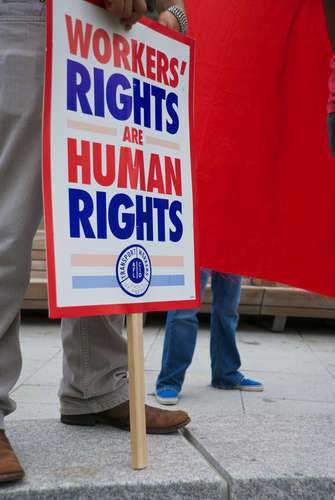
NATIONAL LABOR RELATIONS ACT TEXT
The National Labor Relations Act (NLRA), also known as the Wagner Act, was signed into law in 1935. The purpose of the act was to protect the rights of workers to organize and bargain collectively with their employers. The NLRA established the National Labor Relations Board (NLRB), which is responsible for enforcing the act and resolving labor disputes. In this article, we will explore the history and impact of the NLRA, as well as current issues and challenges facing labor relations in the United States.
History of the National Labor Relations Act
The NLRA was enacted during the Great Depression, a time when workers were struggling to make ends meet and were often subjected to poor working conditions. The act established the right of workers to form and join labor unions, engage in collective bargaining with their employers, and go on strike. These rights were seen as essential to addressing the power imbalance between workers and employers and promoting a more equitable society.
The NLRA also established the NLRB, which is responsible for enforcing the act and addressing labor disputes. The board is an independent agency of the federal government and is tasked with investigating and resolving unfair labor practices committed by either employers or unions.
Impact of the National Labor Relations Act
The NLRA had a significant impact on labor relations in the United States. Prior to the act, workers had very few rights and were often mistreated by their employers. The act helped to level the playing field between workers and employers and gave workers a voice in the workplace.
One of the biggest impacts of the act was the increased popularity of labor unions. With the right to form and join unions protected by law, workers were able to band together to collectively negotiate with employers for better wages, benefits, and working conditions.
The NLRA also helped to establish the principle of collective bargaining, which is the process by which workers and employers negotiate a contract that governs the terms of employment. This process is essential to ensuring that workers have a say in their employment conditions and that employers treat their workers fairly.
Current Issues and Challenges
While the NLRA has had a positive impact on labor relations in the United States, there are still many challenges facing workers and unions today.
One major challenge is the decline in union membership. The percentage of workers who belong to a union has been steadily declining since the 1950s, which has weakened the bargaining power of workers and made it more difficult for unions to negotiate on behalf of workers. According to the Bureau of Labor Statistics, in 2020, the union membership rate was 10.8 percent, down from 20.1 percent in 1983.
Another issue facing unions is the rise of anti-union sentiment among employers. Many employers view unions as a threat to their bottom line and will go to great lengths to prevent their workers from unionizing. This can include intimidating workers, threatening to close a facility if workers unionize, and breaking labor laws.
In recent years, there has also been a push by some lawmakers and business groups to weaken labor protections and restrict the ability of workers to organize. This has included the passage of “right-to-work” laws in some states, which prohibit agreements between unions and employers that require all workers to pay union dues or fees.
Enforcement of the National Labor Relations Act
The NLRB is responsible for enforcing the NLRA and investigating unfair labor practices committed by either employers or unions. Unfair labor practices can include a range of actions, such as discrimination against workers for engaging in union activities, retaliation against workers for filing complaints with the NLRB, and failure to bargain in good faith with a union.
When the NLRB receives a complaint of an unfair labor practice, it will conduct an investigation and may hold a hearing to determine whether a violation has occurred. If a violation is found, the board can order the employer or union to cease and desist from the unfair labor practice and take corrective action, such as offering reinstatement to a worker who was wrongfully terminated.
In some cases, the NLRB may file a lawsuit in federal court to enforce its orders. However, the ability of the board to enforce its orders has been limited in recent years due to understaffing and budget constraints.
Conclusion
The National Labor Relations Act has had a significant impact on labor relations in the United States, giving workers the right to organize, bargain collectively, and go on strike. The act has helped to level the playing field between workers and employers and promote a more equitable society.
However, challenges remain, including the decline in union membership and anti-union sentiment among employers. It is important for lawmakers and policymakers to continue to support the NLRA and work to strengthen labor protections for workers. By doing so, we can ensure that workers have a voice in the workplace and that employers treat their workers fairly.
What is the National Labor Relations Act of 1935?7
The National Labor Relations Act of 1935 (Public Law 74-198) is also known as the Wagner Act, after New York Senator Robert Wagner who introduced the bill. This bill codified a number of protections for non-farm, non-governmental employees to organize and collectively bargain with employers. This legislation became law on July 5th, 1935 and also enforced standards of conduct against employers that might sanction or retaliate against workers that form unions. Additionally, the National Labor Relations Act facilitated the creation of the National Labor Relations Board that maintains regional offices to help workers in various locations organize, file complaints and collectively bargain.
What are the provisions of the National Labor Relations Act?
This Act ensured the rights of employees to collectively bargain, choose their labor representative and negotiate the terms of their employment. This includes all workers, unionized or otherwise. This protection is stated in Section 1 of the bill.
The National Labor Relations Act defines five unfair labor practices in Sections 7 and 8:
– Abridging the rights of employees to associate and organize into a labor organization that would collectively bargain for fair wages and working conditions
– Interfering or coercing members of a labor organization
– Discrimination against employees that support or oppose a union
– Discrimination against employees that exercise their rights to testify against their employer
– Refusal to allow required collective bargaining with union officials.
The most prominent and important provision by far is the emphasis on collective bargaining with rules governing the responsibility of the employer during collective bargaining, the selection and representation of the workers during the meetings and the clear definition of employees as a class independent of their employer.
What is collective bargaining?
Collective bargaining is the process by which employers and employee representatives meet and negotiate terms of employment such as wages, benefits and dispute resolution mechanisms. The right to collective bargaining is generally guaranteed by law and expressed in employer-employee contracts and agreements. Some workers, such as public servants, do not have the right to collectively bargain, as the nature of their jobs differ, working for taxpayers. Public workers however, receive better protections against arbitrary and unfair employer practices by nature of built in safeguards and protections for government employees. Collective bargaining agreements are agreed upon for a number of years and are revisited before their expiration to determine new terms.
How is the National Labor Relations Act enforced?
The National Labor Relations Board is the supervisory body that manages the formation of unions and prosecutes violations of the National Labor Relations Act. Under the watch of the NRLB, unionized and non-unionized workers alike are guaranteed federal protections to demand better wages and conditions. This includes protections against employers as well as labor unions themselves that may potentially prevent their members from organizing against an employer.
The National Labor Relations Board also provides a number of services for workers, not the least of which is holding elections to certify and decertify unions. Through NLRB regional offices, a secret ballot election is held among eligible workers and at least 30% of employees must participate in the election. If a majority is achieved, then the NRLB will declare a union that has collective bargaining rights for the employee against the employer. The rules for these elections are usually determined by the involved parties, but the NRLB will facilitate and oversee the election for fairness and transparency.
Alternatively, employees may seek recognition of a union without the aid of the NLRB through a majority agreement with the workers, voluntarily accepted by the employee. In this event, workers retain the right to have a secret ballot referendum on the voluntarily accepted union under the auspices and supervision of the NRLB. In the event that parties or individuals are dissatisfied with the NRLB office, they many contact the parent organization in Washington DC for a review of the case. If the case passes the scrutiny of an attorney and supervisors, it is considered by the governing board.
The NRLB maintains 34 local offices serving all fifty states across state boundaries to take regional and population distribution into consideration. The San Francisco office, for example, services Northern California, with a representative in Hawaii for logistical efficiency. Los Angeles has two NRLB offices that split up Southern California. Every office maintains dispute resolution services and administers rulings over illicit employer dealings. Online, the NRLB maintains guides for employers and employees to remain within the boundaries of the law.
What are criticisms of the National Labor Relations Act?
Aside from initial reactions of the Act as supporting the spread of socialism in organized labor, the National Labor Relations Act garnered opposition for favoring unions over employees in what ought to be impartial negotiations. Additionally, before the merger of the American Federation of Labor and the Congress of Industrial Organizations, there was a split between allowing plant-wide elections for union formations or relegating union formation for specific sets of workers, with similar skills and demands. The NLRB initially favored the latter approach to union building.
The constitutionality of the National Labor Relations Act was challenged by the Jones & Laughlin Steel Corporation and the case eventually reached the Supreme Court. The company had fired ten workers for attempting to unionize and the NRLB ruled in favor of the fired employees. The company decided to challenge the enforceability of the decision. The Supreme Court affirmed the right of the federal government to regulate relations between employers and their employees by way of the interstate commerce clause to prevent the obstruction and burdening of commerce between states.
How has the National Labor Relations Act been amended?
The 1947 Taft-Hartley Act was passed with the intention of halting some of the rights given to unions to strike and imposing limitations on the union leaders. Certain types of strikes were outlawed, such as “wildcat striking” which was striking without union approval. Additionally, “closed shop” workplaces that mandated that all employees join a union were made illegal. “Right to work” laws further protect employees from mandatory membership in labor unions and these laws are effective in 22 states, many in the South and Plains states. The intention of these laws is to stop “forced unionism” and blunt the power of unions in a system that is argued to favor unions over employers. Critics argue that such measures create a class of unrepresented workers that receive unequal treatment, sometimes positive, sometimes negative due to their lack of union representation.
The Taft Hartley Act has been viewed as an unfair infringement on the rights of workers in the workplace by limiting their ability to strike and creating fractured union solidarity as some employees will choose not to join the union. This will either weaken the union’s position or create a free rider problem, with non-union workers benefiting from paid dues and workplace improvement gains made by union workers, in spite of not paying to financially support then union.
In 2009, the provisions of the Act were modernized to decrease potential delays in collective bargaining and to strengthen penalties against employers that intimidate employees away from union membership.
Timeline of important events
1932 Norris-La Guardia Act
Employers must not contractually ban a worker from joining a labor union when considering employment.
1935 National Labor Relations Act
This act provided significant protections for unionized workers and demonstrated a process by which they could collectively bargain for their rights.
1937 National Labor Relations Board v. Jones & Laughlin Steel Corporation
The National Labor Relations Act is held constitutional by the interstate commerce clause and employers may not retaliate against employees for organizing for better wages and conditions.
1947 Taft Hartley Act
In response to a number of post-war labor disruptions, this act limited actions that unions and union members could take and set the precedent for right to work laws that ended forced unionism for all workers.























